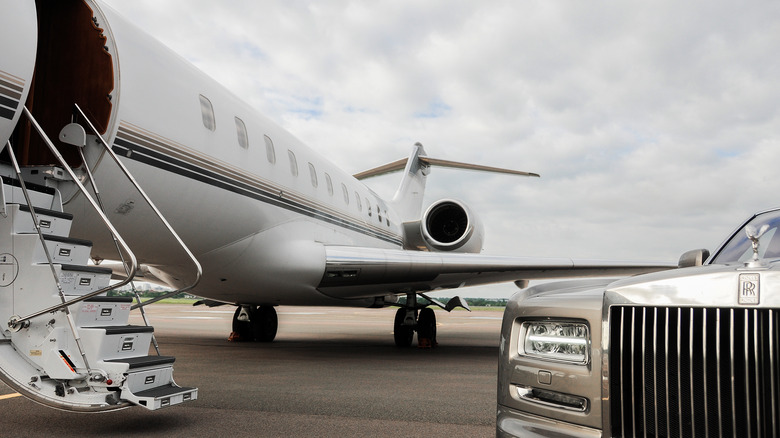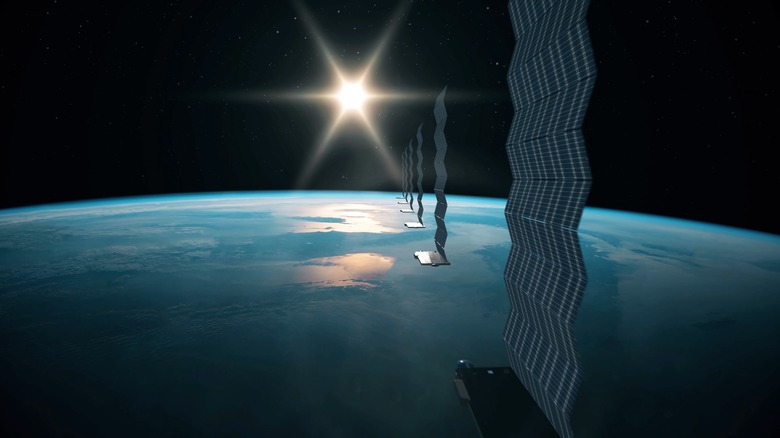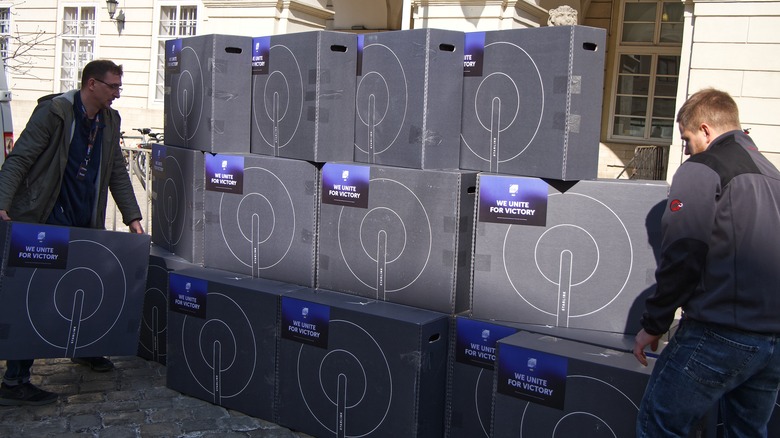After Boats And RVs, Now Starlink Service Is Coming To Planes
Starlink has announced it is launching another service, though it's not intended for the average consumer. Starlink Aviation promises reliable internet and fast speeds while you're high in the air — but to sign up for the service, you'll need a plane of your own, $150,000 worth of equipment, and the means to pay a five-figure monthly fee. There is a chance airlines could sign up for the service, as something similar has been tested by the likes of Delta. So even if you're not a multi-millionaire, you might still get to experience the service at some point in the future.
Starlink launched its first batch of satellites in 2019 and has been consistently expanding its network ever since. The service's original purpose was to provide internet access to underserved areas around the globe. For example, providing modern fiber broadband to sparsely populated rural areas is pretty cost-prohibitive due to the amount of infrastructure work required. Starlink, on the other hand, simply requires a terminal, a subscription, and an area with satellite coverage.
The standard home service was joined by an RV service that allowed users to take Starlink on the move earlier this year. The RV plan, while portable, initially couldn't be used in a vehicle while it was actually moving. However, the FCC recently approved Starlink's portable service for actual in-transit use. A more expensive service designed for use on boats and yachts was the most recent launch, and now with the land and sea covered, Starlink is taking to the skies.
High-speed internet for high-speed travel
If you've ever used Wi-Fi on a plane, you'll notice the service can fluctuate from sort of okay to slow, spotty, and borderline unusable. According to Starlink, that isn't the case with its Aviation package. The company says its service is so good that customers can enjoy " video calls, online gaming, virtual private networks and other high data rate activities" while up in the air. Starlink also promises global coverage, with its web of satellites covering most of the land, sea, and even parts of the polar region.
There are some notable exceptions, with countries like Iran, Russia, Venezuela, and China lacking coverage, according to Starlink's map. Certain areas on the map, including a large portion of the United States, are also subject to a waitlist. It is currently unknown if the Aviation service receives priority in waitlisted areas, or if it is slowed during peak hours like Starlink RV. It is also unknown whether the service will work over large, unserviced countries like Russia or if those areas are a total dead zone for all of Starlink's products.
With Starlink, passengers will be able to access high-speed, low-latency internet from the moment they walk on their plane â†' https://t.co/bcn8jvpKgi pic.twitter.com/mDDQou1ZA3
— SpaceX (@SpaceX) October 19, 2022
Starlink says the service can provide up to 350 Mbps of bandwidth to each plane with the kit installed and an active subscription. That's faster than basic Starlink, which hovers between 50 Mbps and 250 Mbps, but slower than its $500-a-month premium service, which can reach speeds of 500 Mbps. Latency can also be as low as 20ms. Starlink hasn't said when its aviation service is due to take off, but those both rich enough and interested can put their email addresses on a reservation list.
Starlink Aviation has a sky high price tag
Private jets are expensive to buy, expensive to maintain, and expensive to run. Starlink Aviation fits into that price bracket quite well. As with the other versions of Starlink on the market, there's an initial cost for the equipment you need along with a monthly fee to use the service. The hardware is under warranty as long as a subscription to the service is maintained, and no long-term contracts are involved. While there's a chance that the exact details will vary, Starlink's other plans have an option to easily pause the subscription, so you'll only pay for the months when you actually use the service. And given the price tag, a pause function could save Starlink Aviation's customers a significant amount of money.
The hardware you need will set you back $150,000, and that doesn't include the cost of installation. That hardware includes an "electronically steered phased array antenna," which Starlink claims is extremely reliable and offers a high level of performance. The company implies that installation isn't too complex and can be done alongside the plane's routine maintenance. The six-figure kit includes an Aero Terminal, a power supply, two wireless access points, and harnesses. When you've bought the necessary equipment, and paid someone to safely fit it onto your plane, you've got the initial expenses out of the way.
As astronomical as those expenses seem, a year of Starlink Aviation could end up costing you more. The service costs between $12,500 and $25,000 per month and at present there is no indication of what lands you in the $12.5k bracket, under what circumstances you'll pay double that, and what everything in between involves.
Starlink has caused some controversy
Starlink has been the subject of controversy in recent weeks, mainly due to its involvement in the Russia-Ukraine war. The system and its founder, Elon Musk, initially received heavy praise when thousands of terminals were shipped to Ukraine, and the Eastern European country was given free access to the service. Starlink proved to be a vital tool for the Ukrainian government and military. Conventional internet services, along with other infrastructure, have been heavily damaged by Russian shelling and missile strikes.
As it is only reliant on a terminal having power and connecting to a satellite, Starlink can allow users to connect to the internet with nothing but a terminal and a generator. The only way Russia could disrupt the service is with direct attacks and satellite jamming technology, which Musk claims Starlink is constantly working to counteract. He also claims the extra effort needed to keep Starlink going in an active warzone means the service provided to each terminal is costing around a hundred times more than it costs to provide internet to a standard home user living somewhere like the United States.
Musk has cited the costs of operating the service as an excuse while debating whether or not to cut Ukraine off from Starlink. The idea of shutting the service down first surfaced after Musk tweeted a peace plan and was met with a severe backlash from Ukrainians and their supporters. The billionaire hasn't said his threats to shut the service off are a response to that backlash, and has since withdrawn them completely. Last week, Musk confirmed Starlink would stay on in Ukraine, despite the costs and the U.S. government not entertaining his requests that it foots the entire bill.



